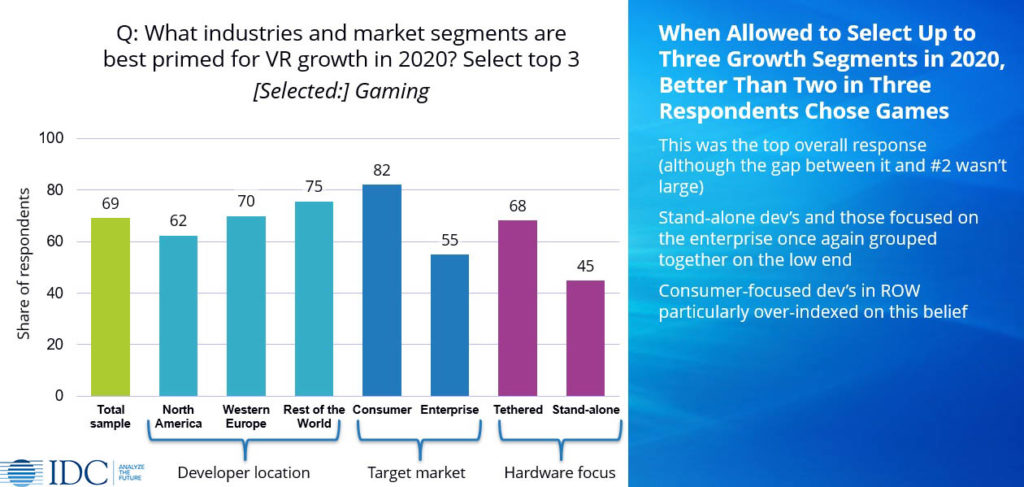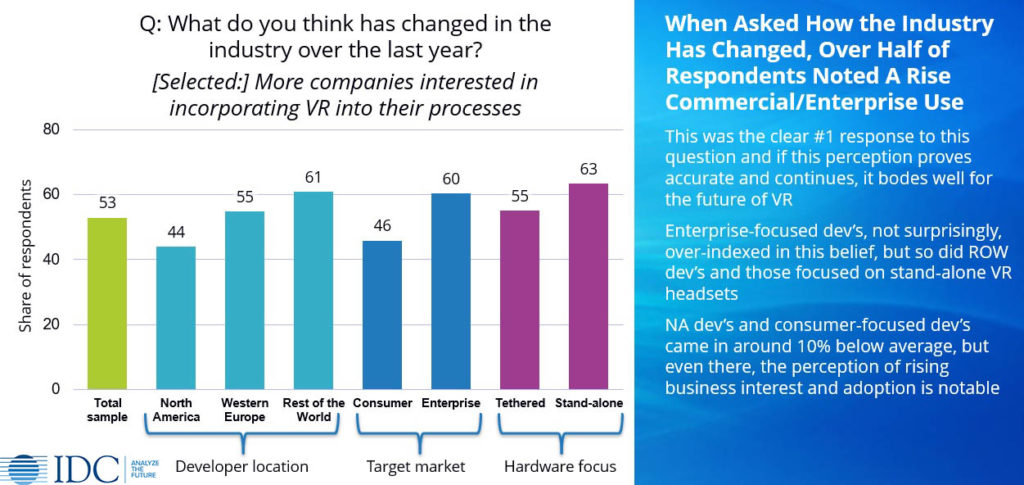With everything else going on today, it’s easy to overlook the fact that Virtual Reality (VR) has been on a quiet roll in recent quarters. IDC’s latest Worldwide Quarterly Augmented and Virtual Reality Headset Tracker, for example, estimates that VR hardware shipments will rise 5% in 2020 compared to 2019, to about 5.7 million devices. There’s an important dynamic within this mix, though: we expect mobile VR products to largely fall off a cliff (-62% annual growth) while PC- and game console-tethered VR HMD (head-mounted displays) shipments should rise 13%, and stand-alone VR HMDs should jump 23% this year, so parts of the market appear to be growing quite healthily.
Groundbreaking hardware came to market last year to boot, and consumers certainly gave Valve’s Half-Life: Alyx game a big thumbs up in late 1Q20. Oculus’ standalone Quest, HTC’s VIVE Pro Eye (a tethered HMD with eye-tracking) and VIVE Cosmos, and Valve’s tethered Index headset all debuted last year. Since late March there’s been an eye-opening spike in monthly Steam VR use. From last October-November to this April-May, to be more specific, the share of Steam users that accessed VR each month roughly doubled, from roughly 1% to 2% of that massive gamer community – and most of that increase coincided with the release of Half-Life: Alyx and the associated spike is even more impressive since the COVID-19 pandemic has driven up Steam’s user base dramatically starting in March.
VR Dev Insights: A Joint IDC-HTC VIVE Survey
In order to get an insider’s view on the state of VR, IDC teamed up with HTC VIVE late last year as that organization geared up for its annual survey of VR app/game developers. IDC helped design the survey and got the full banner books, which we then independently analyzed. The result was a joint report, Worldwide VR Game and App Developer Survey Insights, 1Q20, that got published a couple weeks ago.
A bit of housekeeping before we get into the key findings. First, the survey was fielded online to adults in late January (data were collected before the effects of the COVID-19 pandemic were widely felt). Although the survey was available globally and collected nearly 350 responses across scores of countries, it was fielded in English, which may help explain why most of the respondents hailed from North America (33%) and Western Europe (37%); the other 30% resided elsewhere. The survey was promoted via HTC VIVE’s developer newsletter and associated social accounts. Data were cleaned but not weighted. Most VR developers belonged to teams of <6 members, skewed young and male, and had 3+ years of game/app dev experience under their belts.
Headlines, Please
Okay, of the VR game and app developers surveyed, one of the clearest signals was that developers believed more companies are incorporating VR into their processes in 2020 and are shifting their budgets accordingly. The respondents also felt gaming was best positioned for growth this year – but training and simulation use cases in the enterprise was a close second on this measure.
Let’s drill down on these findings. Figure 1 shows the results to the question, “What industries and market segments are best primed for VR growth in 2020?” Note that respondents could choose up to three markets (out of nine options) plus an “I don’t know” response. 69% of respondents (n=342), chose gaming, making it the top overall “vote getter”.

As can be seen in Figure 1, we further broke down the results by respondents’ region, whether their main target market for current project(s) was enterprises or consumers, and whether the HMD(s) they focused on were tethered or standalone. As indicated, the belief that gaming was best primed for growth this year was most strongly felt among developers in the Rest of World (ROW) region and among those with a consumer orientation and a tethered hardware focus.
63% of respondents selected “Training / Simulation” as the market best primed for 2020 growth, however, making it a strong 2nd finisher. “Education” came in third at 41%.

Figure 2 shows the results to another question, “What do you think has changed in the industry over the last year?” There were six response options here, plus an open text field. The #1 “vote getter”, at 53% of the total, was “More companies interested in incorporating VR into their processes”. VR dev’s in ROW and in Western Europe felt more strongly about this than those in North America, especially if the dev’s had an enterprise orientation and focused on standalone hardware.
The second and third most selected options to this question were “Better development tools and documentation” (43%), and “Wider end-user adoption” (42%). Both are welcome news too.
Another noteworthy finding was that multiplatform development is the norm: three in four developers surveyed thought that being platform/hardware agnostic enabled greater success and they were targeting multiple platforms in their current VR project(s).
Room to Improve
When asked about the main industry challenge, respondents most often cited the cost of VR hardware, followed by a general lack of awareness or interest in VR. This is consistent with separate IDC survey data.
A key process challenge noted was weakness related to server-side integration. Most developers felt game engines and middleware tools and documentation had gotten better in the past year, but how their VR project(s) intersect servers was a sticking point that vendors should work to address.
Takeaways
Okay, let’s wrap up with a few actionable takeaways:
- Anecdotal discussions with various vendors and end user organizations since COVID-19 hit suggest that the pandemic has given VR something of a tailwind. The need for virtual training and collaboration has risen since in-person training and other group activities is no longer viable in many cases, for example, and the bump that the pandemic has given to gaming broadly since March has been well-documented.
- 2020 may be VR gaming’s biggest year yet from a revenue perspective. The burn may have been slow through 2019, but IDC research suggests that VR game spending across all platforms/HMDs will top $1 billion this year.
- Enterprise spending on VR training/simulation assets may ramp quickly in late ’20, and 2021 could be this use case’s strongest year yet by revenue (with education use cases also increasing). The survey suggested this may happen, and since it can take months for enterprises to deploy VR hardware and get budget for custom training/sim content approved, it may not be until 2021 that a wave of stepped-up enterprise spending is actually realized.
- Untethered experiences seem to be where the market’s trending. This is clear from IDC’s hardware shipment data, but “Tethering / lack of mobility” was also noted by respondents as the third most important general market challenge (behind hardware costs and lack of VR interest or awareness).
- Dev toolmakers need to help dev’s by shoring up how VR projects relate to server-side assets/services (enterprise-focused dev’s were especially concerned about this issue).
If more insights along these lines sound interesting, follow me on Twitter (@LewisAWard) and check out the Gaming CIS fact sheet and the AR/VR CIS fact sheet.
Explore the full results of the “Worldwide VR Game and App Developer Survey Insights” survey:




